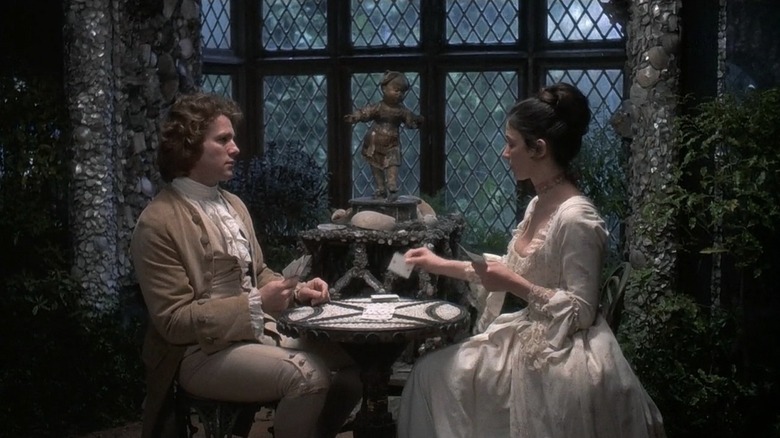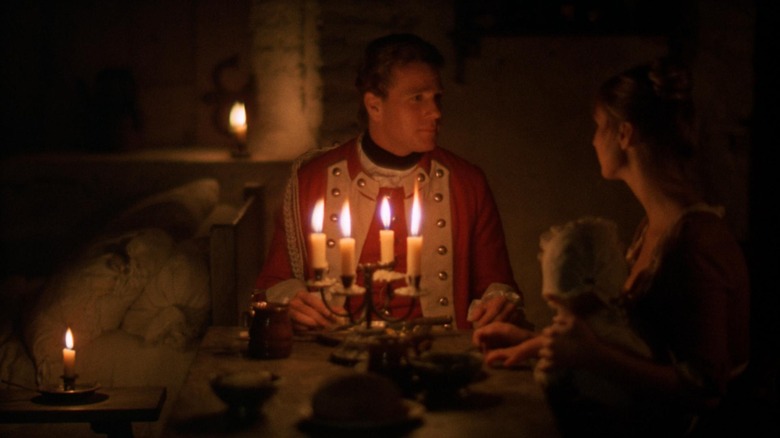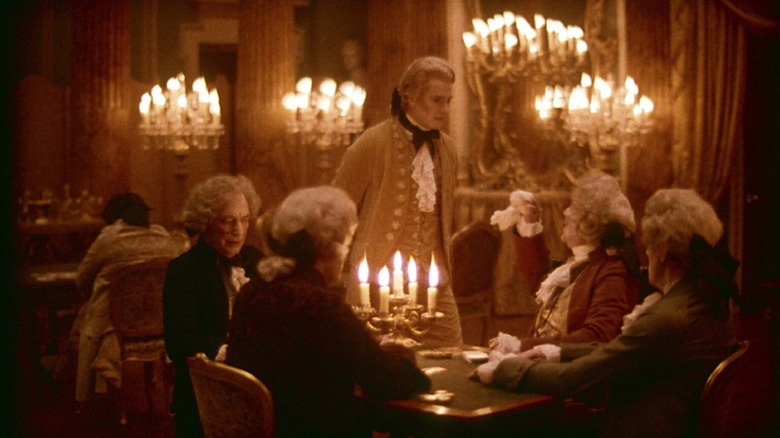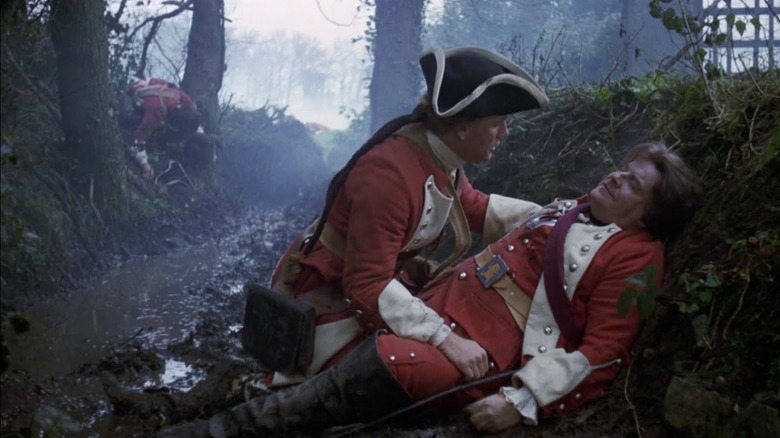Stanley Kubrick Borrowed Some NASA Tech To Capture Barry Lyndon's Natural Look
Stanley Kubrick's 1975 epic "Barry Lyndon" is one of the most beautifully photographed movies ever committed to celluloid. The film's cinematographer John Alcott had previously shot "2001: A Space Odyssey" and "A Clockwork Orange" for Kubrick, and would win an Academy Award for his work on "Lyndon." Alcott would also shoot "The Shining," as well as the sleazy but gorgeous-looking B-movies "Terror Train," "Vice Squad," and "The Beastmaster."
The warm, dim, flame-dappled, Vermeer-like shimmer of "Barry Lyndon" came from Kubrick's insistence that the film be shot entirely with natural light. Because the film was set in the 1770s and 1780s, that meant there were to be no electric lights whatsoever. If a scene was set outdoors, the lighting would be dictated by where the sun was — and what the weather was like — at time of shooting. Indoor scenes set at night would be lit with nothing less than hundreds and hundreds of candles. Intimate scenes were lit with oil lamps. There was a time when the world was just darker.
In the 1984 book "Kubrick," — handily archived on the website Cinephilia & Beyond — author and journalist Michel Ciment interviewed Kubrick about his use of natural light in "Barry Lyndon," and Kubrick answered at length about why he made the decisions he did. Kubrick also addressed some of the technical challenges he faced in bringing certain scenes into his lens, going into detail about how 35mm film tends to behave in low light, the importance of shutter speeds, and other fascinating shop talk. When it comes to making a film look as downright beautiful as "Barry Lyndon," these details are fascinating. And involve borrowing technology from NASA.
Aperture adjustment
Ciment asks Kubrick rather directly why he prefers natural light. Kubrick's response may strike a reader as pragmatic, but also mildly illogical, given how meticulously orchestrated his films tend to be. This is the director, mind you, who is notorious for demanding dozens upon dozens of takes until he gets a scene "just right." But, given Kubrick's background in photography (his profession prior to becoming a filmmaker), his feelings track. Kubrick said:
"Because it's the way we see things. I have always tried to light my films to simulate natural light; in the daytime using the windows actually to light the set, and in night scenes the practical lights you see in the set. This approach has its problems when you can use bright electric light sources, but when candelabras and oil lamps are the brightest light sources which can be in the set, the difficulties are vastly increased."
It's important to know a little bit about old-world analogue photography moving forward, as the difficulties Kubrick alludes to are all based on things like aperture adjustment. In very, very brief, most cameras have an adjustable aperture that can manually control the amount of light coming into a lens. A smaller aperture will let in very little light and is better for bright, sunlit, outdoor scenes. Less light means more visibility. For darker scenes, an aperture would need to be opened quite widely. The troublesome issue is that adjusting the aperture also effects the focus of a shot, and can sometimes make for softer or even blurry images.
A faster lens
A film camera shutter usually clicks open and exposes the film for only about one fiftieth of a second. Kubrick explains that he needed more. In order to let in more light than a shutter click, Kubrick needed to find a faster lens. The size, length, and shape of the lens, as well as an increased shutter speed would go a long way to dictate the number of foot-lamberts being let into the camera. Kubrick needed something that could peer into a dark space. The filmmaker, though, having worked on "2001: A Space Odyssey," happened to know exactly what kind of lens that was typically used for peering into dark spaces: NASA satellite lenses. And rare ones that. He explained it all at length:
"Prior to Barry Lyndon, the problem has never been properly solved. Even if the director and cameraman had the desire to light with practical light sources, the film and the lenses were not fast enough to get an exposure. A 35mm movie camera shutter exposes at about 1/50 of a second, and a useable exposure was only possible with a lens at least 100% faster than any which had ever been used on a movie camera. Fortunately, I found just such a lens, one of a group of ten which Zeiss had specially manufactured for NASA satellite photography. The lens had a speed of f0.7, and it was 100% faster than the fastest movie lens."
The lenses not only let in light, but allowed a greater depth of field; Alcott and Kubrick were able to shoot wide shots with only candles.
The problem solved
Of course, the new challenge was mounting such a lens on a typical 35mm film camera. The lens in question, as one might imagine, was much larger than the lenses typically used for film production, and getting the light to land on a film strip needed adjustment. In order to get the lenses closer to the actual moving film strip, the cameras have to be rebuilt and new kind of camera rotating shutter had to essentially be invented from scratch. Once that camera had been built, however, shooting "Barry Lyndon" became easy. Indeed, a lot of older technical problems had been eliminated, as Kubrick elucidates:
"A lot of work still had to be done to it and to the camera to make it useable. For one thing, the rear element of the lens had to be 2.5mm away from the film plane, requiring special modification to the rotating camera shutter. But with this lens it was now possible to shoot in light conditions so dim that it was difficult to read. For the day interior scenes, we used either the real daylight from the windows, or simulated daylight by banking lights outside the windows and diffusing them with tracing paper taped on the glass."
With nothing but natural light being let into the camera, and only diffused lamplight coming in through the windows, Kubrick would never have to worry about shooting directly into a light source by accident. With such a camera, lens flare would resemble something more akin to the iris adjustment of an actual human eye, and the camera would never seem to be artificially blasted out.
The room may have been dim enough to interfere with reading, but the film image was now clearer than ever.



